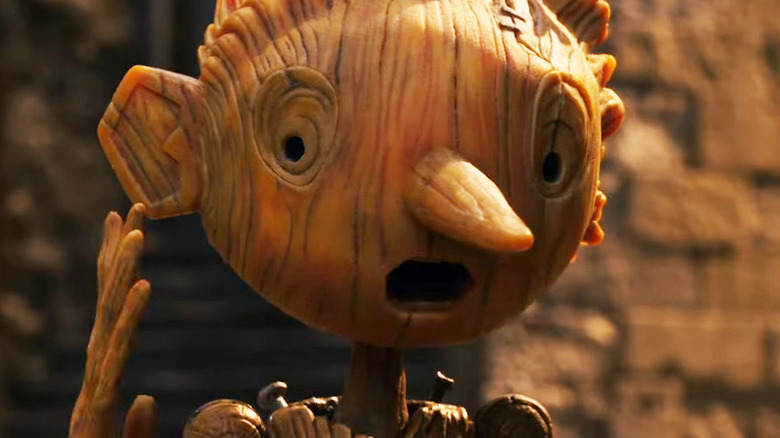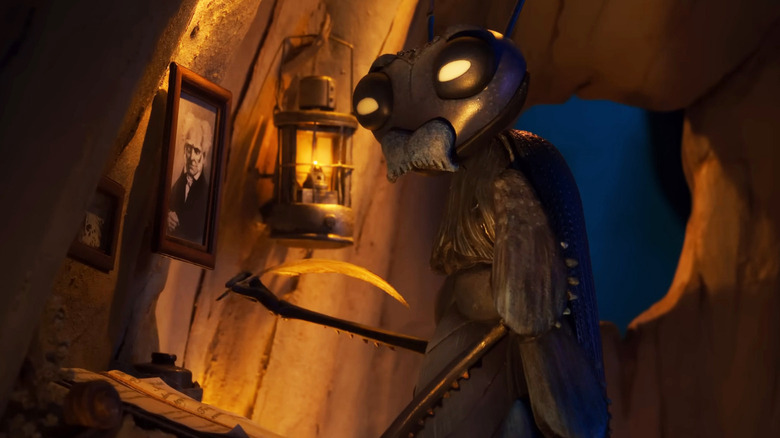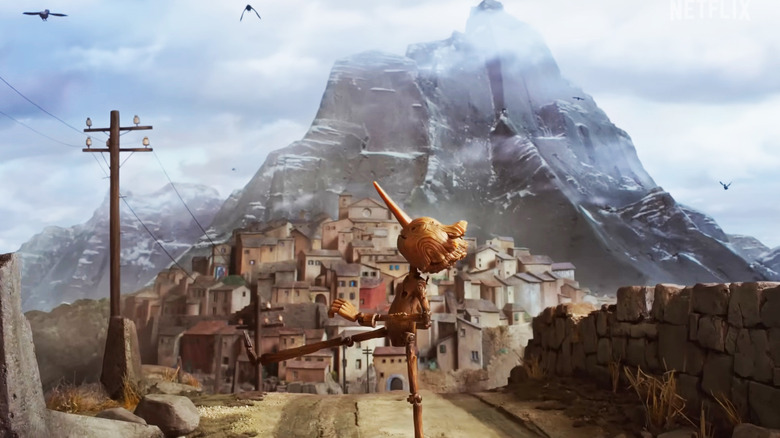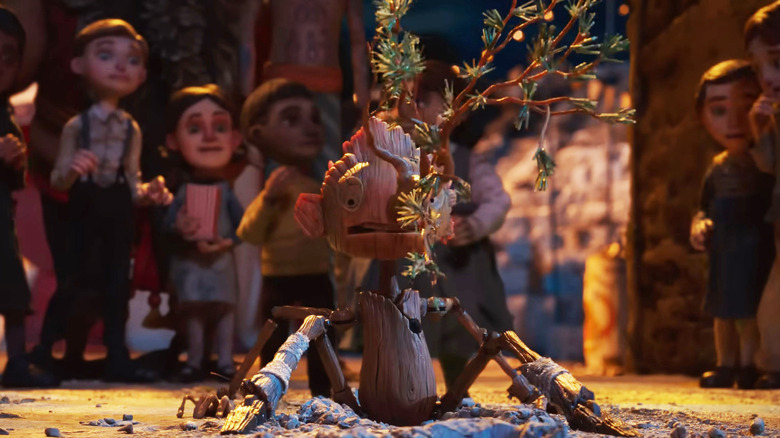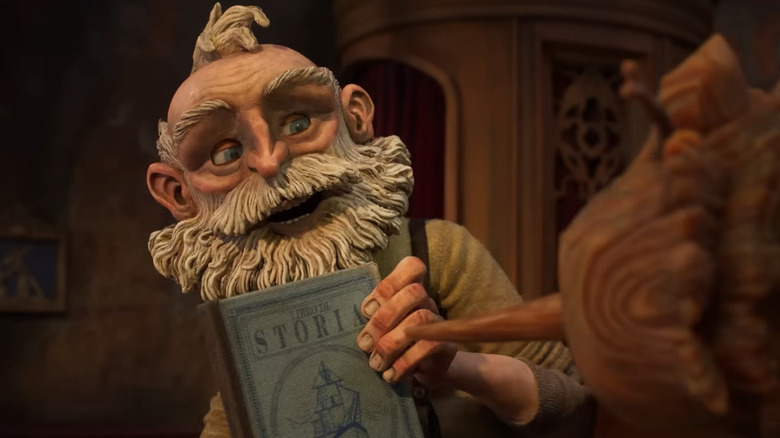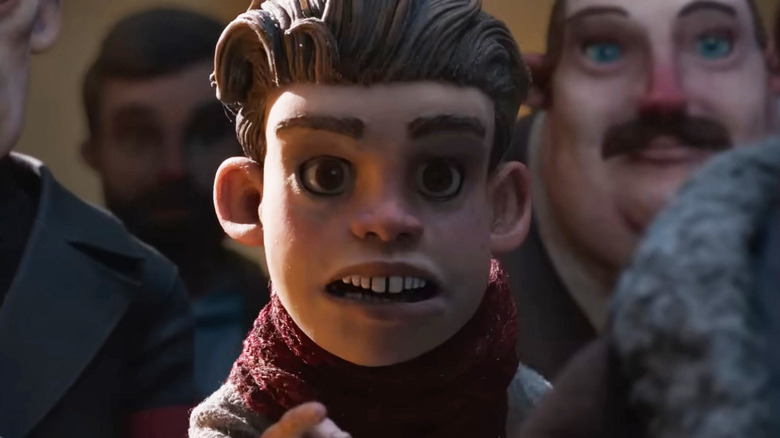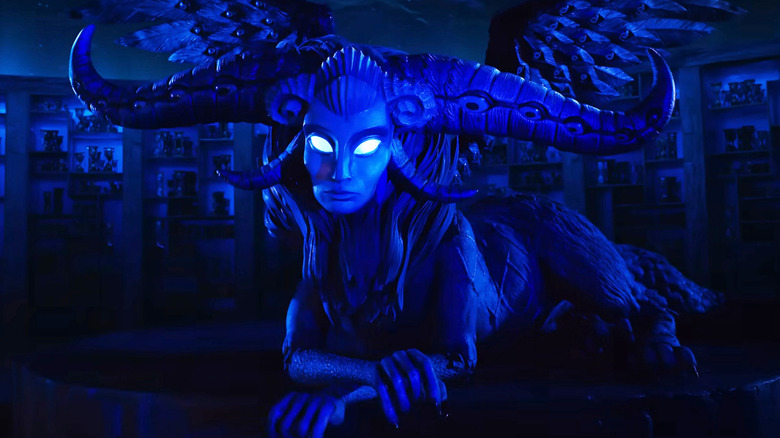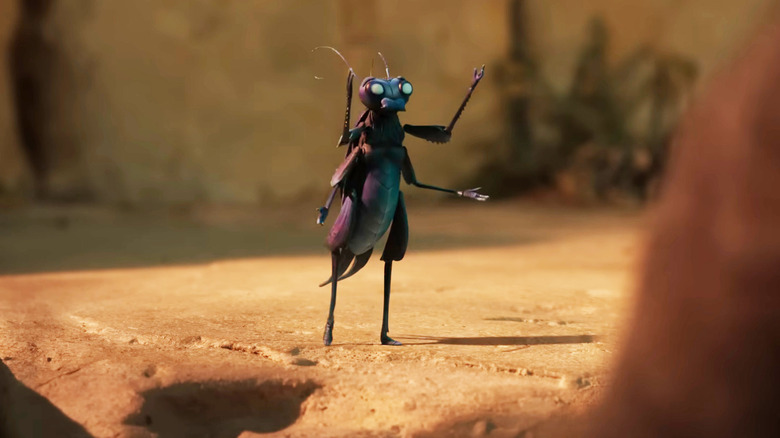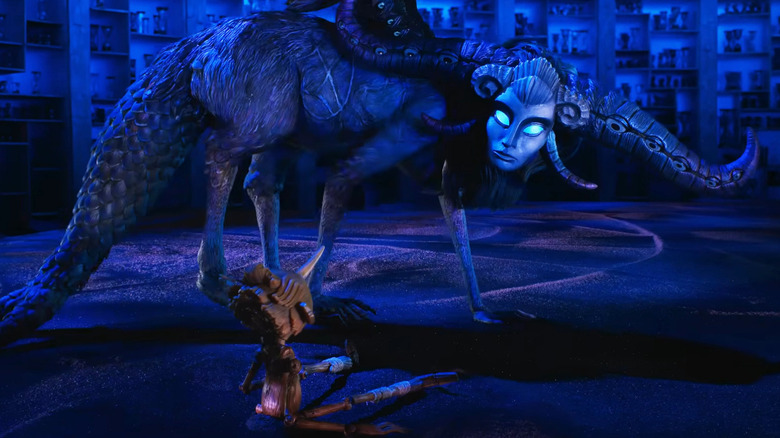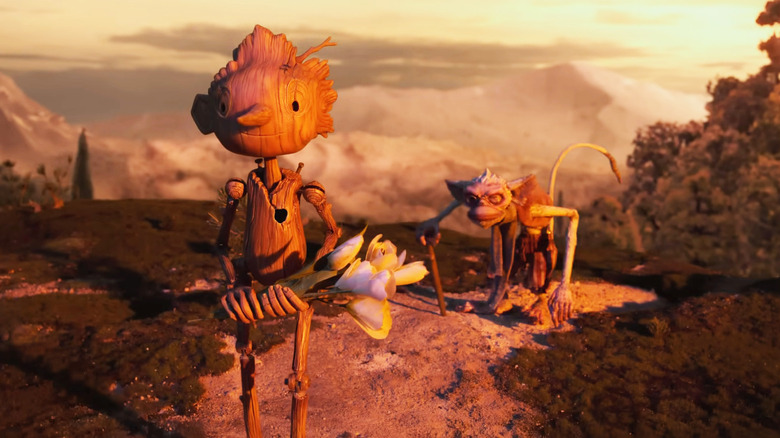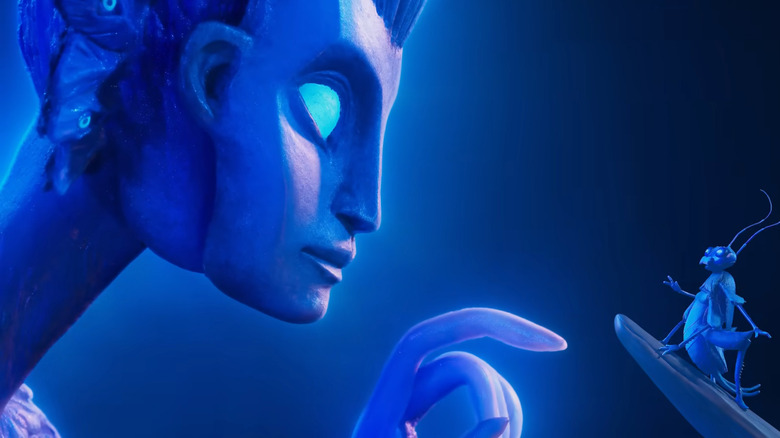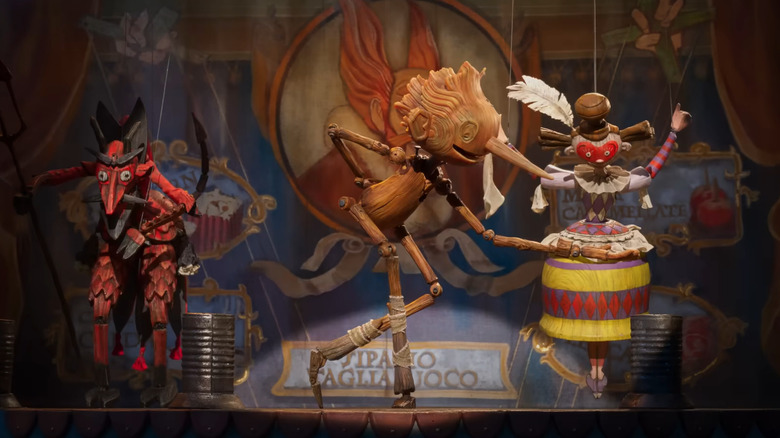The Ending Of Guillermo Del Toro's Pinocchio Explained
This post contains spoilers for "Guillermo del Toro's Pinocchio."
Guillermo del Toro is a renowned writer and director who's known not just for creating insightful stories but also for visually striking films. From del Toro's best movies to his worst, he always finds a way to present characters, worlds, and plots that are uniquely memorable. With "Pinocchio," del Toro may be telling a story that people have heard before, but his version reimagines the classic tale in ways that will shock and delight all his viewers.
As one might expect from a del Toro film, "Pinocchio" has a somewhat dark tone. Even when the film celebrates humanity, it isn't afraid to show that humans can be callous and cruel. It's still a family film, but there are plenty of deep themes at play that only adults will notice when they sit down to watch it. "Pinocchio" doesn't start out the way fans of the Disney classic remember, and it ends in a dramatically different place as well. If parts of the film's conclusion left you scratching your head, this should clear things up.
The story was anti-fascist
The historical setting of "Guillermo del Toro's Pinocchio" immediately lets you know that the film will have a more serious focus than past versions of the story. The beginning of the story takes place in the midst of World War I, and as warplanes are making their way back to base, they drop bombs just to lighten their load. One of those bombs lands on Geppetto's church and kills his son Carlo.
From there the film's antiwar message becomes even more explicit. By the time Geppetto creates Pinocchio, many years have passed. World War I has come to a close, but now Benito Mussolini has come to power in Italy and fascists dominate almost every aspect of daily life in Geppetto's town and the surrounding areas. Geppetto, like many of the other Italian citizens, does his best to play along with what the fascists want in order to avoid any violence at their hands.
Pinocchio isn't so agreeable. He's a rambunctious young boy who likes to do things his own way. Just by being himself, Pinocchio shines a light on just how wrong the fascist belief system is. The primary antagonists of the film, the carnival owner Count Volpe and the government representative Podestà, are both fascists who want to crush Pinocchio's spirit for the glory of the fatherland. It's Pinocchio's individualist streak, unlimited optimism, and empathy for other people that ultimately lets him prevail over his foes.
Disobedience is Pinocchio's greatest virtue
In all its different forms, Pinocchio's story is partly a coming-of-age tale about a boy learning how to be good and take responsibility for his actions. In most versions of the tale, like Disney's classic rendition from the 1940s, learning to be good is synonymous with learning to obey the people who are supposed to be in charge. Pinocchio usually learns that if he follows what the adults in his life tell him, then things will generally work out for him.
In Guillermo del Toro's version of the story, however, most of the adults in Pinocchio's life are fascists, espousing terrible rules and life philosophies that only serve to devalue other people. Geppetto might not truly be a fascist himself, but even Pinocchio's father can't serve as a great example for the young boy because he's willing to go along with what the fascists want.
Unlike past versions of the story, Pinocchio in this film doesn't need to learn how to obey. His disobedience is what sets him apart from the other people in his life, and it's what makes him a hero. For del Toro, Pinocchio's disobedience in the film is the whole point. "Disobedience now is more urgent than ever," the filmmaker told The Washington Post. Pinocchio's real journey through the movie was him learning how to use that disobedience to help others, like when he broke Death's rules and hourglass in order to save Geppetto's life.
Hardship taught Pinocchio to be good
Pinocchio doesn't learn how to be obedient in the film, but he does learn how to be good. At the beginning of the movie, Pinocchio breaks rules to get what he wants. He leaves Geppetto's house to follow his father to church. He skips out on going to school because he wants to drink hot chocolate at the carnival. By the end of the movie, he's breaking rules to save lives. What changed?
Pinocchio's journey away from home takes him through plenty of hardships, but two moments in particular demonstrate how Pinocchio's experiences led him to change his attitude in life. First, Pinocchio sees Count Volpe beating and berating Spazzatura. He immediately steps in to defend the monkey, and when that doesn't work, the two of them conspire to sabotage the Count's performance for Benito Mussolini. Later Pinocchio is taken to a training camp for fascist soldiers. There he comes to understand that his old bully Candlewick was really just being cruel because that's what his father Podestà taught him to do. Pinocchio and Candlewick become friends and rebel against Podestà's rules.
Over the course of the film, Pinocchio suffers, but he also witnesses others suffering because of the people who are in charge of them. All of that convinces him to change the way he goes about disobeying and transforms him into a true hero.
Pinocchio changed everyone around him
Pinocchio isn't the only one who changes over the course of the film. He also transforms the people who are closest to him. Geppetto goes through the biggest change, but Sebastian's transformation has the biggest effect on the film's plot.
After Geppetto loses his son Carlo, all his joy for life vanishes. His work slows down to the point that even when his town's church gets rebuilt, he never finishes his new crucifix carving because he spends the majority of his time drinking. The war ends in 1918, Benito Mussolini rises to power in Italy in 1922, and Geppetto remains lost. The Wood Sprite gives Pinocchio life so he can bring joy back into Geppetto's life. The two of them get off to a rough start, but by the end of the movie, Geppetto has found love and motivation all over again. He's willing to risk being eaten by a monstrous sea creature just to see Pinocchio again.
Sebastian begins as a self-centered writer whose main interest in Pinocchio is that he already has a home set up inside the wood of the puppet's body. The Wood Sprite promises Sebastian one wish if he teaches Pinocchio to be good, but things actually work out in the opposite direction. Sebastian tries giving Pinocchio a lesson or two, but by spending time with the boy, Sebastian himself learns to be more selfless. He uses his wish, not for fame but to bring Pinocchio back to life.
Candlewick became his own man
There's another character in the movie who goes through a drastic change thanks to Pinocchio, and his transformation mirrors Pinocchio's own growth. Candlewick is the son of Podestà, a war-obsessed fascist government official who lives in Pinocchio's town. When the boys first meet, Candlewick takes a cue from his father and acts like a bully toward Pinocchio, going so far that he convinces Pinocchio to stick his wooden legs in a fire.
All that changes in the film's final act. Podestà ships Candlewick off to a special military training camp for young boys, and eventually he finds a way to get Pinocchio to the camp as well. Podestà is obsessed with the idea of using Pinocchio as an immortal soldier, but neither of the children is genuinely interested in fighting a war.
At the training camp, Candlewick confesses to Pinocchio that he just wants to make his father proud of him, and Pinocchio comforts him by telling him all fathers love their sons, but fathers are still people and don't always behave the way they should. In a training exercise, Pinocchio and Candlewick come to a tie, and Podestà orders his son to shoot his new friend. Candlewick refuses, finally telling his father that he doesn't need his approval. He and Pinocchio rebel against the camp's leadership just as bombs begin to fall.
Death knew Pinocchio would be resurrected
Guillermo del Toro spends some time musing on mortality in "Pinocchio." Shortly after Count Volpe's carnival is introduced, the Count and Geppetto get into a fight over Pinocchio that ends when the puppet gets hit by Podestà's car. To the humans, it appears as though Pinocchio died, but he wakes up in a version of the afterlife populated by skeletal rabbits and a sphinx-like creature called Death who says that the Wood Sprite is her sister.
Death tells Pinocchio that the Wood Sprite brought him to life because she doesn't care about following rules. Then Death explains the rules of Pinocchio's new almost-afterlife. Every time he dies, he'll arrive in her world and have to wait for larger and larger hourglasses to run through their sand before he gets sent back to the world of the living. Near the end of the movie, Pinocchio dies while Geppetto is drowning, and he breaks the hourglass to get back more quickly, even though it means he'll become truly mortal.
Pinocchio dies one final time in his efforts to save Geppetto, but thanks to Sebastian's wish and the Wood Sprite's magic, he gets resurrected and has the chance to live out his life with his family. Death may have warned Pinocchio that by breaking the hourglass he'd gain mortality and become "a real boy," but she also knew that her sister would intervene. Death's warning was more about testing Pinocchio's character than it was about limiting his lifespan.
Sebastian was narrating from the afterlife
When Sebastian enters the film, he begins narrating different events. He explains that when he first met Pinocchio, he was a writer working on a book about his life, and he tells the story of how he first got involved with Geppetto, his puppet, and the Wood Sprite. At the end of the film, Sebastian talks about Pinocchio's long life with Geppetto and Spazzatura, who both eventually die as Pinocchio goes on agelessly.
In some instances of Sebastian's narration, the camera shows him writing as he's speaking, which made it all the more surprising when Sebastian begins to narrate over his own death. Just after seeing that Sebastian, like the others, died, we catch up with him in the afterlife, playing cards with the skeletal rabbits who work for Death. The transition makes for a quick twist. It reveals that all this time, Sebastian wasn't narrating from some grand book that he wrote about his adventures. He gave up that dream in order to save Pinocchio's life. Instead, Sebastian has been telling his life story to the disinterested rabbits over a few hands of poker. The darkly humorous turn in the story is emblematic of what sets "Guillermo del Toro's Pinocchio" apart from other takes on the story.
Pinocchio is still technically immortal...
Sadly, Pinocchio outlives Geppetto, Spazzatura, and Sebastian. He's not a human being, and he never ages, even as the people around him do. The tragic part of his existence is something that Death warned him about when he first visited her domain. At the time, Pinocchio was thrilled at the prospect of being immortal, but Death told him that immortality is actually more of a curse than a blessing.
When Pinocchio decided to break Death's hourglass so he would have enough time to save Geppetto from drowning in the sea, she told him that not following her rules would make him mortal again. Did the Wood Sprite's final spell, fulfilling Sebastian's wish, undo Pinocchio's newfound mortality?
Yes and no. Pinocchio is still on his "last life" like Death told him he would be. The Wood Sprite gave him one more chance at that life, but she didn't make Pinocchio truly immortal again the way he was before breaking the hourglass. That said, Pinocchio is still a wooden puppet, so he isn't likely to die from old age anytime soon. At the end of the film, Sebastian says that he imagines Pinocchio didn't live forever, but his friend still gets to have an extraordinarily long life compared to normal humans.
...but he did become a real boy
In the film, Death claims that Pinocchio's "realness" is tied to his mortality. She says that human life is special because it is short, but even though Pinocchio gets to live for a very long time, he's still gone through the transformation of becoming a real boy by the end of the film.
In more traditional versions of Pinocchio's story, like Disney's classic film, his journey ends when he gets magically transformed into a physical human being. That was never going to be the case in Guillermo del Toro's version. "To me, it's essential to counter the idea that you have to change into a flesh-and-blood child to be a real human," the director told Vanity Fair. "All you need to be human is to really behave like one, you know?"
Pinocchio's transformation from an inhuman puppet to a real boy was a slow process that began when he first met Geppetto at the beginning of the film. In a way, every interaction he had with the people he met further pushed him toward humanity, but it was the moment that Pinocchio smashed Death's hourglass that sealed his fate. By being so full of love that he was willing to sacrifice his own life, Pinocchio truly embodied what it means to be human.
The Wood Sprite remains a mystery
Despite her massive impact on everything that happens to Geppetto, Sebastian, and Pinocchio, the movie doesn't reveal all that much about the Wood Sprite. She first appears as a collection of glowing orbs that seemingly take interest in Geppetto's suffering as he chops down a tree while mourning the death of his son Carlo. In his narration, Sebastian admits that he knows very little about what the orbs are or why they're suddenly flocking to Geppetto's side.
Later, when Pinocchio visits the afterlife for the first time, Death tells him that the Wood Sprite is her sister. The two of them definitely share a resemblance, with large wings that appear to have eyeballs sticking out all over them. Over the course of the film, however, Death gets more screen time and has much more to say than her sister.
In her final appearance in the film, the Wood Sprite grants Sebastian his wish and returns Pinocchio to life. It seems like she might have known that things would work out this way all along, and it's unclear how much she and her sister communicated and planned during the events of the film. Ultimately, the Wood Sprite has little to say or reveal, she's simply a mysterious force of nature that will never be fully understood.
Pinocchio gets to live out a full life
What happens to Pinocchio now? At the end of the movie, his family has died, and though the exact timeline is never made clear it seems likely that the world has changed quite a bit. When Pinocchio first comes to life, Benito Mussolini has taken power in Italy and fascism is on the rise throughout Europe. Depending on how long Geppetto and the others lived, Pinocchio might be on his own just on the other side of World War II.
Pinocchio has a real sense of adventure, and he's never been afraid to explore new experiences. It seems more than likely that after Geppetto and the others died, Pinocchio left his small Italian town behind and ventured off into the wider world. The film doesn't say anything about the adventures that Pinocchio goes on later in his life, but wherever he goes, he's sure to continue being a positive influence on everyone he meets.
Sebastian says that he believes Pinocchio won't live forever, and based on what Death told Pinocchio during his last visit, that seems like a safe assumption. Whether or not Pinocchio ever makes it back to his hometown and Geppetto's little house, there's definitely hope that he and his Papa get reunited in the afterlife some decades down the road.
